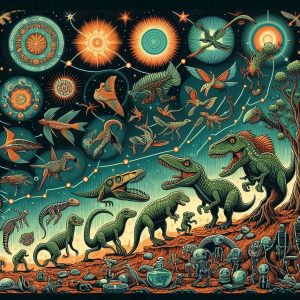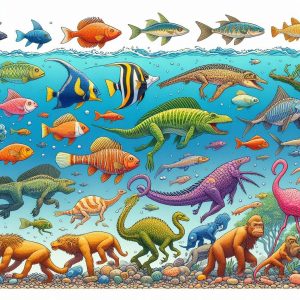Introduction of Vertebrate Evolution
Vertebrate evolution is a fascinating journey through Earth’s history, highlighting the rise and diversification of animals with backbones. This evolutionary lineage includes fish, amphibians, reptiles, birds, and mammals, each adapting to various environmental challenges and opportunities over millions of years. For a comprehensive overview of Vertebrate Evolution, visit Britannica’s Vertebrate Overview.
Vertebrate Evolution
Origins of Vertebrates in Vertebrate Evolution
The origins of vertebrates can be traced back to the Cambrian period, approximately 541 million years ago. Early vertebrates were jawless fish, known as agnathans, which evolved from invertebrate ancestors. These primitive vertebrates developed essential features like a notochord, a dorsal nerve cord, and gill slits. For more on the origins of vertebrates, check out Nature’s article on vertebrate origins.
Evolutionary Adaptations in Vertebrate Evolution
Throughout their evolutionary history, vertebrates have developed numerous adaptations that have enabled them to survive and thrive in various environments. These adaptations include the development of limbs for terrestrial locomotion, specialized respiratory systems, and complex reproductive strategies. To learn more about these adaptations, see NCBI’s article on vertebrate adaptations.
Impact of Climate and Environmental Changes
Climate and environmental changes have played a crucial role in shaping vertebrate evolution. Historical events, such as ice ages and mass extinctions, have driven the adaptation and diversification of vertebrates. Current climate change continues to affect vertebrate species, influencing their behavior, distribution, and survival. More information can be found at ScienceDirect’s article on climate impact.
![]()
Major Evolutionary Milestones
Vertebrate evolution is marked by several significant milestones, including the development of jaws, the transition from water to land, and the evolution of flight. Each of these milestones involved complex anatomical and physiological changes, driven by genetic mutations and environmental pressures. Learn more about these milestones at Britannica’s Vertebrate Evolution.
Key Stages in Vertebrate Evolution
The evolution of vertebrates is marked by several key stages, starting from early jawless fish to the development of tetrapods and the emergence of mammals. These stages highlight the major transitions and adaptations that have occurred over millions of years. Learn more about these stages from Britannica’s overview of vertebrate evolution.

Cambrian Explosion
The Cambrian Explosion, approximately 541 million years ago, was a pivotal period in the history of life on Earth. This era saw the rapid diversification of life forms, including the first appearance of early vertebrates. These jawless fish, known as agnathans, were among the first to develop a primitive backbone. For a deeper dive into the Cambrian Explosion, visit Britannica’s Cambrian Period.
Devonian Period: Age of Fishes
The Devonian Period, also known as the “Age of Fishes,” occurred around 419 to 359 million years ago. This period saw the emergence of jawed fish, such as sharks and bony fish, as well as the first tetrapods—vertebrates that began to venture onto land. The transition from water to land was a significant evolutionary step, leading to the diversification of amphibians. Learn more from Nature’s article on the Devonian Period.
Carboniferous Period: Rise of Amphibians
The Carboniferous Period, from about 359 to 299 million years ago, is known for the extensive swampy forests that provided a habitat for the early amphibians. During this time, amphibians became more diverse and widespread, laying the foundation for the later evolution of reptiles. Visit Britannica’s Carboniferous Period for more information.
Mesozoic Era: Age of Reptiles
The Mesozoic Era, spanning from 252 to 66 million years ago, is often called the “Age of Reptiles.” This era is characterized by the dominance of dinosaurs, the evolution of the first birds from theropod dinosaurs, and the emergence of mammals. The Mesozoic Era ended with the Cretaceous-Paleogene extinction event, which led to the extinction of the non-avian dinosaurs. Discover more at National Geographic’s Mesozoic Era.
Cenozoic Era: Age of Mammals
The Cenozoic Era, beginning 66 million years ago and continuing to the present, is known as the “Age of Mammals.” Following the extinction of the dinosaurs, mammals rapidly diversified and became the dominant land animals. This era saw the evolution of primates, including humans, and significant climatic changes that influenced mammalian evolution. For more on the Cenozoic Era, check out Britannica’s Cenozoic Era.
Recent Advances in Vertebrate Evolution Research
Recent advances in technology, such as genome sequencing and fossil analysis, have provided new insights into the evolutionary history of vertebrates. These tools have allowed scientists to trace evolutionary lineages, understand genetic adaptations, and reconstruct ancient environments. For the latest research updates, visit ScienceDirect’s Vertebrate Evolution.
| Period/Era | Timeframe | Key Evolutionary Event |
|---|---|---|
| Cambrian | 541-485 million years ago | First appearance of early vertebrates (jawless fish) |
| Devonian | 419-359 million years ago | Emergence of jawed fish and first tetrapods |
| Carboniferous | 359-299 million years ago | Rise and diversification of amphibians |
| Mesozoic | 252-66 million years ago | Dominance of dinosaurs, emergence of birds and mammals |
| Cenozoic | 66 million years ago-present | Diversification of mammals and evolution of humans |
Fossil Evidence in Vertebrate Evolution
Fossils provide a window into the past, offering crucial evidence of the anatomical changes that have occurred over millions of years. Key fossil discoveries, such as the Tiktaalik and Archaeopteryx, highlight the transition from aquatic to terrestrial life and the evolution of birds from theropod dinosaurs. For detailed fossil records, visit FossilEra.
Modern Vertebrate Diversity
Today, vertebrates are incredibly diverse, ranging from the smallest fish to the largest mammals. This diversity is a result of millions of years of evolution, driven by natural selection, genetic mutations, and environmental changes. For more insights into modern vertebrate diversity, check out the resources at NCBI.
| Epoch | Significant Event | Major Vertebrate Group |
|---|---|---|
| Cambrian | Explosion of marine life | Jawless Fish |
| Devonian | Transition to land | Tetrapods |
| Mesozoic | Dominance of dinosaurs | Reptiles |
| Cenozoic | Rise of mammals | Mammals |
Future Directions in Vertebrate Evolution
Ongoing research in Vertebrate Evolution continues to uncover new insights into how vertebrates have adapted and diversified over time. Advanced technologies such as genome sequencing and computational biology are opening new avenues for understanding evolutionary processes. Stay updated with the latest research from ScienceDirect.
Adaptive Radiation in Vertebrates Evoluation
Adaptive radiation is a process where organisms diversify rapidly into a multitude of new forms, particularly when a change in the environment makes new resources available or creates new challenges. Vertebrates have shown remarkable adaptive radiation, particularly after mass extinctions. An example is the diversification of mammals after the Cretaceous-Paleogene extinction event. More on adaptive radiation can be found at NCBI’s article on adaptive radiation.

Impact of Climate Change on Vertebrate Evolution
Climate change has historically been a major driver of Vertebrate Evolution. Shifts in climate have forced species to adapt, migrate, or face extinction, influencing evolutionary paths and shaping biodiversity. Current climate change continues to impact vertebrate species, affecting their distribution, behavior, and survival.
Historical Climate Events and Vertebrate Evolution
Throughout Earth’s history, major climate events have led to significant evolutionary changes in vertebrates. For example, the end-Permian mass extinction, triggered by massive volcanic eruptions and climate shifts, wiped out about 90% of marine species and 70% of terrestrial vertebrates, paving the way for the rise of the dinosaurs in the subsequent Triassic period. Learn more from ScienceDirect’s article on mass extinctions.
The Pleistocene Ice Ages in Vertebrates Evoluation
The Pleistocene epoch, often referred to as the Ice Ages, saw repeated glacial cycles that profoundly impacted vertebrate evolution. Large mammals, such as mammoths and saber-toothed cats, adapted to the cold climates, while others migrated to warmer regions or became extinct. For more on the Pleistocene’s impact on vertebrates, visit Britannica’s Pleistocene Epoch.
Current Climate Change and Its Impact
Today’s rapid climate change is having a significant impact on vertebrates. Species are shifting their ranges towards the poles or to higher altitudes to escape warming temperatures. Changes in precipitation patterns and extreme weather events are altering habitats and food availability, leading to changes in migration patterns, breeding seasons, and survival rates. Detailed studies on current climate change impacts can be found at IPCC’s Sixth Assessment Report.
![]()
Adaptation and Migration
Vertebrates have shown various adaptive strategies in response to climate change. Some species adapt through changes in physiology and behavior, while others migrate to more suitable habitats. However, the rapid pace of current climate change poses challenges, as not all species can adapt or migrate quickly enough to survive. More on adaptation strategies can be found at Nature’s article on adaptation.
Extinction Risks
Climate change increases the risk of extinction for many vertebrate species, especially those with limited ranges or specialized habitats. Coral reef fish, polar bears, and amphibians are among the species most vulnerable to climate-related extinction. Conservation efforts are crucial to mitigate these risks and protect biodiversity. For more information, visit World Wildlife Fund’s page on climate change effects.
| Era/Epoch | Climate Change Event | Impact on Vertebrates |
|---|---|---|
| End-Permian | Massive volcanic eruptions | 90% marine and 70% terrestrial vertebrates extinct |
| Pleistocene | Repeated glacial cycles | Evolution and extinction of large mammals |
| Holocene | Current global warming | Shifts in species distribution and behavior |
Future Directions in Research
Future research on the impact of climate change on Vertebrate Evolution will focus on predicting species’ responses to ongoing and future climate changes. Advanced modeling techniques and long-term ecological studies will be essential in developing effective conservation strategies. For the latest research updates, visit ScienceDirect’s Climate Change section.
Genomic Studies in Vertebrate Evolution
Genomic studies have revolutionized our understanding of Vertebrate Evolution. By analyzing the DNA sequences of various vertebrates, scientists can trace evolutionary relationships, identify genetic adaptations, and uncover the molecular mechanisms behind key evolutionary transitions.
Tracing Evolutionary Relationships
Genomic data allows researchers to construct detailed phylogenetic trees, which illustrate the evolutionary relationships between species. These trees have revealed surprising connections and have often challenged traditional classifications based on morphology. For example, genomic studies have provided insights into the close relationship between birds and dinosaurs. More details can be found at NCBI’s article on phylogenomics.
Identifying Genetic Adaptations in Vertebrates Evoluation
Through genomic studies, scientists have identified specific genes and genetic mutations that contribute to key adaptations in vertebrates. For instance, the evolution of tetrapods from fish involved changes in genes related to limb development and respiratory systems. Genomic research on these adaptations provides a deeper understanding of how vertebrates transitioned from water to land. Visit ScienceDirect’s article on genetic adaptations for more information.
Molecular Mechanisms of Evolution in Vertebrate Evolution
Molecular mechanisms play a pivotal role in driving vertebrate evolution, influencing genetic variation and phenotypic diversity across species. These mechanisms include genetic mutations, gene duplications, epigenetic modifications, and horizontal gene transfer.
Genetic Mutations
Genetic mutations are spontaneous changes in DNA sequences that can lead to new traits and adaptations in vertebrates. Beneficial mutations may enhance survival and reproductive success, contributing to evolutionary fitness. Examples of beneficial mutations in vertebrates include adaptations for antibiotic resistance and environmental tolerance. For more insights, explore Nature’s article on genetic mutations.
Gene Duplications
Gene duplications occur when segments of DNA are duplicated within the genome. These duplicated genes can undergo functional divergence through mutations, leading to the development of new gene functions or regulatory pathways. Gene duplications have played a critical role in vertebrate evolution, contributing to the diversification of gene families involved in sensory perception, immune response, and developmental processes. Learn more from ScienceDirect’s article on gene duplications.
Evolution of Sensory Systems
The evolution of sensory systems in vertebrates, such as vision, hearing, and smell, has been a major focus of genomic studies. By comparing the genomes of different vertebrates, researchers have identified the genetic changes that underpin the development and refinement of these sensory systems. This research sheds light on how vertebrates have adapted to various ecological niches. Learn more from Nature’s article on sensory evolution.
Impact of Genomic Research on Conservation
Genomic studies also play a crucial role in conservation biology. By analyzing the genetic diversity of endangered vertebrate populations, conservationists can develop strategies to preserve genetic variation and enhance species’ resilience to environmental changes. For more information, visit NCBI’s article on conservation genomics.
| Genomic Study Focus | Key Findings | Impact on Vertebrate Evolution Understanding |
|---|---|---|
| Phylogenetics | Revised evolutionary relationships | Enhanced understanding of species connections |
| Genetic Adaptations | Identification of adaptive genes | Insights into Evolutionary Transitions |
| Molecular Mechanisms | Gene duplication, horizontal transfer | Deeper knowledge of evolutionary processes |
| Sensory Evolution | Genetic basis of sensory system development | Understanding of ecological adaptations |
| Conservation Genomics | Genetic diversity in endangered species | Improved conservation strategies |
Future Directions in Genomic Studies
Future research in vertebrate evolution aims to uncover the genetic and environmental factors that have driven evolutionary changes. Advances in genomic technologies and fossil analysis are providing new insights into the evolutionary history of vertebrates, helping scientists to understand the complex processes that have shaped the diversity of life on Earth. Stay updated with the latest research from Nature’s article on future genomic technologies and ScienceDirect’s Vertebrate Paleobiology and Paleoanthropology.
FAQs About Vertebrate Evolution

What is vertebrate evolution?
Vertebrate evolution is the study of how vertebrates, or animals with backbones, have evolved over time. It examines the genetic, anatomical, and ecological changes that have occurred in vertebrate species from their origins to the present day.
When did vertebrates first appear?
Vertebrates first appeared over 500 million years ago during the Cambrian period. Early vertebrates were small, jawless fish-like creatures. Over time, vertebrates evolved to include a wide variety of species, including fish, amphibians, reptiles, birds, and mammals.
What are some key stages in vertebrate evolution?
Key stages in vertebrate evolution include the development of the backbone, the evolution of jaws, the transition from water to land, the evolution of amniotic eggs, and the diversification of mammals and birds. Each of these stages represents significant adaptations that allowed vertebrates to exploit new environments and ecological niches.
How do scientists study vertebrate evolution?
Scientists study vertebrate evolution through a combination of fossil records, comparative anatomy, genetics, and embryology. Fossils provide direct evidence of past life forms, while comparative studies of living species help scientists understand evolutionary relationships. Advances in genetic research have also allowed scientists to trace the evolutionary history of vertebrates at the molecular level.
Why is vertebrate evolution important?
Understanding vertebrate evolution is important because it helps us comprehend the origins and adaptations of animals, including humans. It provides insights into how life on Earth has changed over millions of years and helps inform conservation efforts by highlighting the evolutionary processes that shape biodiversity.
Disclaimer
The information provided in this FAQ section is intended for educational purposes only. The information provided in this article is for educational purposes only and is not intended as a substitute for professional advice or scientific research. While efforts have been made to ensure the accuracy of the content, it should not be used as a substitute for professional advice or scientific research. Readers are encouraged to consult authoritative sources and experts in the field of vertebrate evolution for more detailed information.
Caution
When studying or referencing vertebrate evolution, it is important to critically evaluate sources and consider the ongoing advancements in scientific research. Evolutionary biology is a complex and evolving field, and new discoveries can continually reshape our understanding of vertebrate history. Always seek guidance from experienced professionals and adhere to ethical research practices.


